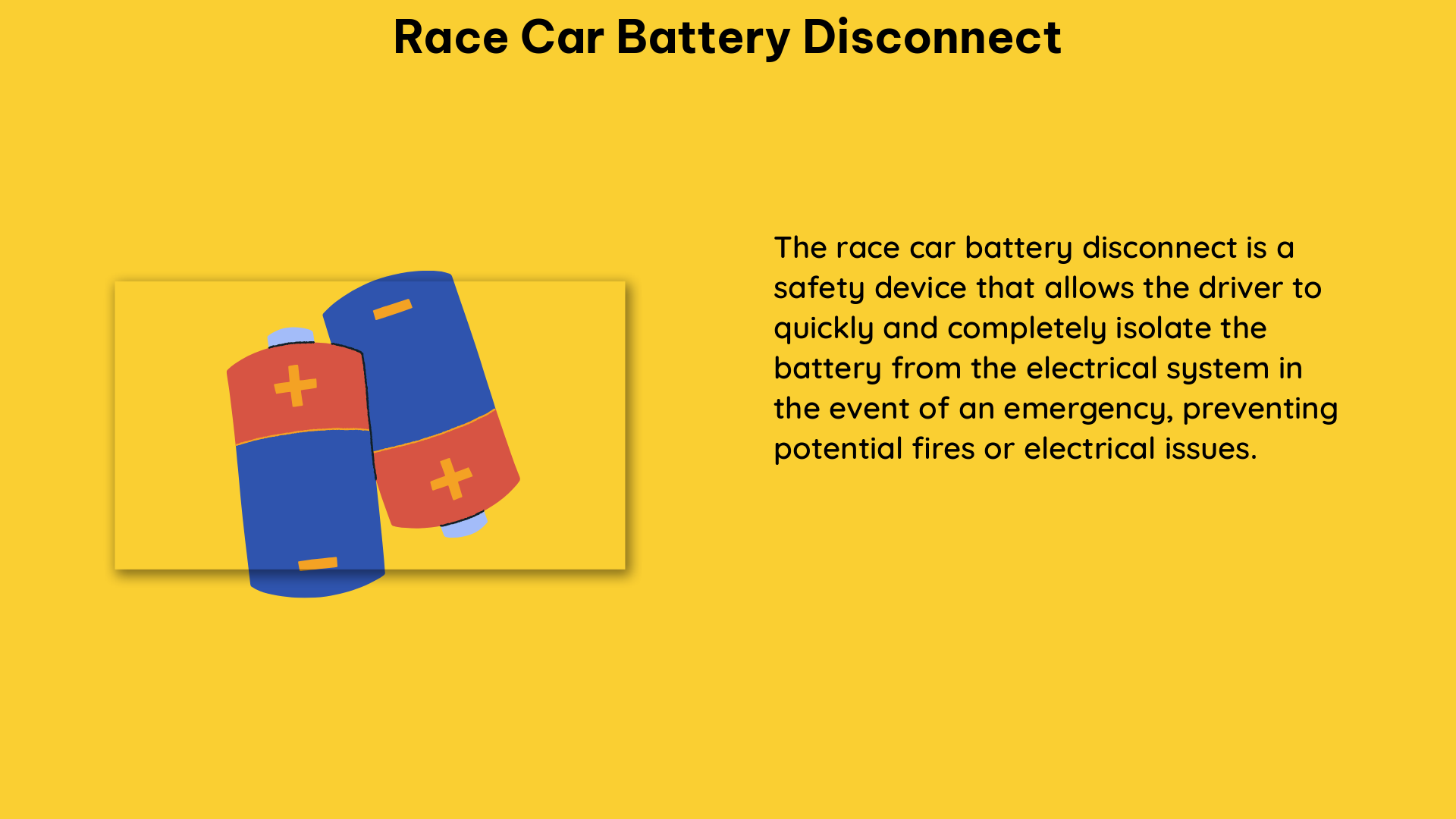When it comes to race car safety and performance, the battery disconnect system is a critical component that deserves meticulous attention. This comprehensive guide delves into the technical specifications, measurable data points, and best practices for selecting and installing a reliable battery disconnect system for your race car.
Circuit Type: Ensuring Proper Isolation
The choice between a single-circuit or two-circuit battery disconnect system can have a significant impact on the overall safety and functionality of your race car’s electrical system. Understanding the differences between these two options is crucial:
-
Single-Circuit Cut-Off Switch: This type of switch is primarily used for working on the car and preventing unintentional starting. It isolates the battery from the entire electrical system, cutting off power to all components.
-
Two-Circuit Cut-Off Switch: This advanced switch is designed for safely turning off a running engine and isolating the battery. It typically has one circuit for the battery and another for the ignition and alternator, ensuring a complete and immediate shutdown of the electrical system in the event of a crash or emergency.
When selecting a two-circuit cut-off switch, it’s essential to ensure that the battery circuit is wired to the negative terminal, while the ignition and alternator circuit is wired to the positive terminal. This configuration guarantees that the electrical system is immediately killed, preventing potential damage to sensitive components.
Wiring Configuration: Ensuring Proper Operation

The wiring configuration of the battery disconnect system is a critical aspect that must be meticulously planned and executed. Improper wiring can lead to catastrophic failures, so it’s crucial to follow best practices:
-
Battery Circuit Wiring: The battery circuit should be wired directly to the negative terminal of the battery. This ensures that the entire electrical system is isolated from the power source when the switch is activated.
-
Ignition and Alternator Circuit Wiring: The ignition and alternator circuit should be wired to the positive terminal of the battery. This configuration, combined with the battery circuit wiring, ensures that the electrical system is immediately shut down in the event of an emergency.
-
Wiring Gauge and Routing: The wiring used for the battery disconnect system should be of sufficient gauge to handle the maximum current draw of the electrical system. Additionally, the wiring should be routed in a manner that minimizes the risk of damage or interference with other components.
Switch Type: Selecting the Right Solution
The choice of switch type for the battery disconnect system can vary depending on the specific requirements of the racing organization and the intended use of the switch. Some common options include:
- Toggle Switches: These simple and reliable switches are often used for basic battery disconnect applications.
- Rotary Switches: Rotary switches, especially those with a keyed lockout feature, are commonly used in racing applications where a more secure and controlled disconnect system is required.
- Push-Button Switches: Push-button switches offer a compact and easily accessible solution for battery disconnect, making them a popular choice for race cars.
Regardless of the switch type, it’s essential to ensure that the switch is rated for at least 100 amps to handle the maximum current draw of the race car’s electrical system.
Switch Location: Ensuring Easy Access and Visibility
The location of the battery disconnect switch is a critical consideration for race car safety. The switch should be positioned within easy reach of the driver, allowing for quick and efficient activation in the event of an emergency. Additionally, the switch should be clearly labeled and visible to the driver and crew, ensuring that it can be quickly identified and operated when needed.
Additional Features: Enhancing Safety and Reliability
Some advanced battery disconnect systems may include additional features to enhance safety and reliability. These features can include:
- Inertia Switches: Inertia switches are designed to automatically activate the battery disconnect system in the event of a sudden deceleration or impact, such as a crash.
- Diodes: Diodes can be incorporated into the wiring to prevent alternator damage and ensure the proper flow of electrical current.
- Fuses: Fuses can be used to protect the electrical system from overcurrent conditions, providing an additional layer of safety.
By incorporating these advanced features, you can further enhance the reliability and safety of your race car’s battery disconnect system.
Conclusion
The battery disconnect system is a crucial component of any race car, and its proper selection, installation, and configuration can mean the difference between a successful race and a catastrophic failure. By following the technical specifications and best practices outlined in this comprehensive guide, you can ensure that your race car’s battery disconnect system is optimized for safety, reliability, and performance.
Remember, when it comes to race car safety, there is no room for compromise. Take the time to carefully plan and execute your battery disconnect system, and you’ll be well on your way to a successful and safe racing season.
Reference:
1. Solid state battery shut off | Yellow Bullet Forums
2. Why battery cut off goes on negative terminal instead of positive?
3. Battery Disconnect Q | Grassroots Motorsports forum

The lambdageeks.com Core SME Team is a group of experienced subject matter experts from diverse scientific and technical fields including Physics, Chemistry, Technology,Electronics & Electrical Engineering, Automotive, Mechanical Engineering. Our team collaborates to create high-quality, well-researched articles on a wide range of science and technology topics for the lambdageeks.com website.
All Our Senior SME are having more than 7 Years of experience in the respective fields . They are either Working Industry Professionals or assocaited With different Universities. Refer Our Authors Page to get to know About our Core SMEs.